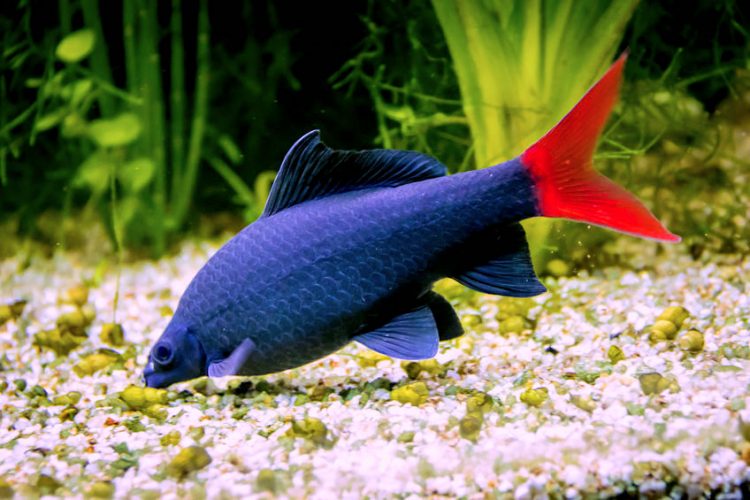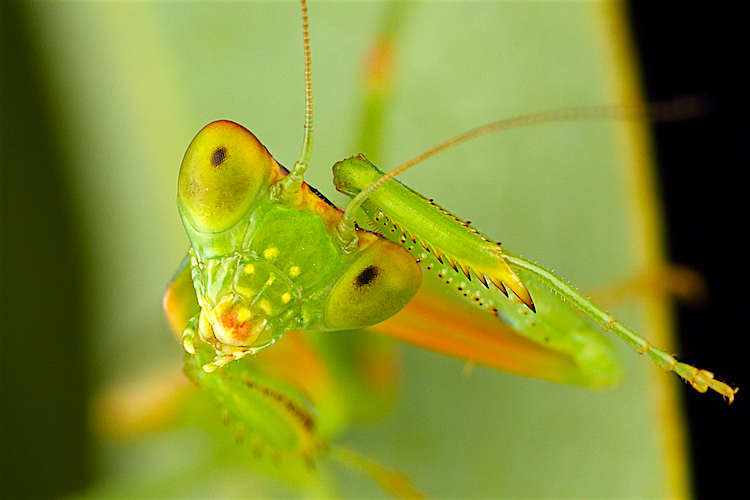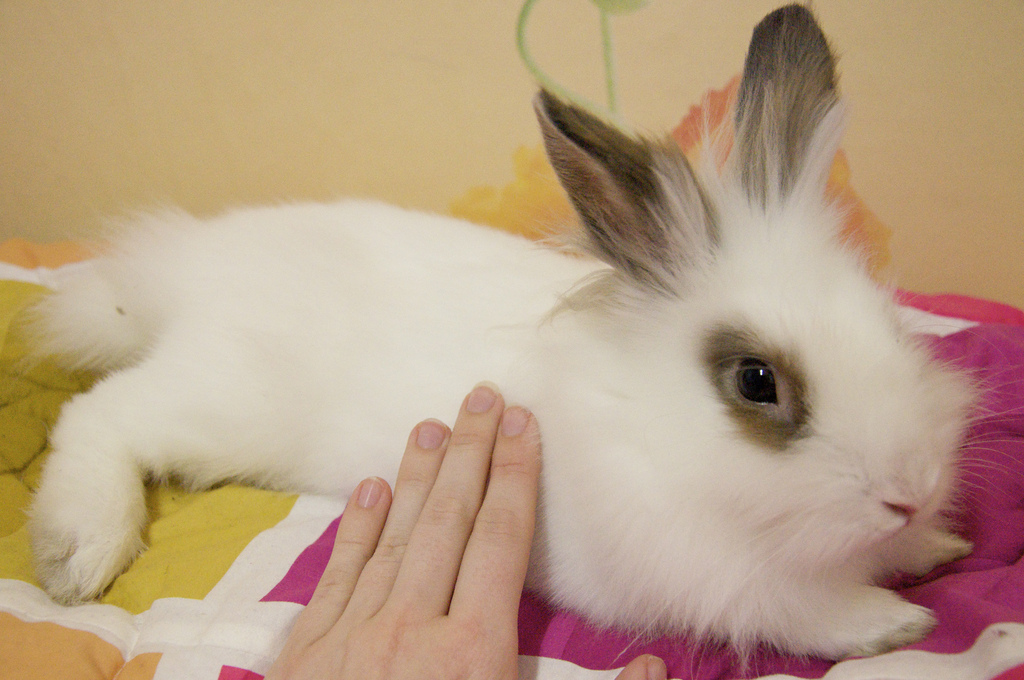How to Keep a Red Tail Black Shark Happy in Your Tank
Caring for a Red Tail Black Shark is tricky because these fish are aggressive and territorial with tankmates. Here’s what you need to know.

- The Unique Appeal of the Red Tail Black Shark
- My Experience With a Red Tail Black Shark
- Aggression and Territorial Behavior in Red Tail Sharks
- Commonly Asked Questions About Red Tail Black Sharks
- Tank Requirements for Red Tail Black Sharks
- Ideal Tankmates for Red Tail Black Sharks
- Breeding Red Tail Black Sharks
- Red Tail Black Shark vs. Rainbow Shark
- Where to Find a Red Tail Black Shark and What to Look For
- Final Thoughts on Owning a Red Tail Black Shark

Don’t leave your pet’s safety to chance
Sign up for Petful recall alerts today.

The Unique Appeal of the Red Tail Black Shark
A striking focal point of any large aquarium, the Red Tail Black Shark (Epalzeorhynchos bicolor) is a unique fish with a semi-aggressive personality. Known for its large black body and vivid red tail, this species can grow up to 6 inches in length and typically lives 6–10 years. Rarely, some have been reported to live up to 18 years.
These fish are native to Thailand, though they are thought to be extinct in the wild due to poaching. They now thrive in the aquarium trade. Interestingly, the Red Tail Black Shark is more closely related to carp than to actual sharks, as it belongs to the Cyprinidae family.
My Experience With a Red Tail Black Shark
When I kept my 55-gallon planted aquarium, I had one of these stunning fish. He quickly became the unrivaled boss of the tank community. The Red Tail Black Shark claimed a cave as his territory, chasing away any tankmates that ventured too close.
- Tankmates like Zebra Danios (Zebra Danios care) and White Cloud Mountain Minnows (White Cloud Mountain Minnow care) displayed tight schooling behavior when my Red Tail Black Shark was nearby.
- Unfortunately, Swordtail fish (Swordtail care) did not fare well. One Swordtail was chased out of the tank entirely, which resulted in its tragic loss.
Aggression and Territorial Behavior in Red Tail Sharks
Caring for Red Tail Black Sharks isn’t too difficult, but selecting the right tankmates is crucial due to their semi-aggressive nature. They don’t inflict physical damage but can stress other fish with their territorial behavior.
- Ideal Tankmates: Semi-aggressive species that can stand up to the Red Tail Shark’s behavior, like Zebra Danios and White Cloud Mountain Minnows, work well.
- Avoid: Peaceful or docile fish like Swordtails, which can’t cope with their aggressive tendencies.
For more information about the species, check the detailed entry on Epalzeorhynchos bicolor.
Commonly Asked Questions About Red Tail Black Sharks
Are Red Tail Sharks Aggressive?
Yes, Red Tail Black Sharks are aggressive and territorial toward tankmates. It’s crucial to select semi-aggressive fish that can withstand this behavior.
To reduce aggression, consider the following:
- Provide plenty of hiding spaces: Driftwood, artificial caves, and plants will help break the line of sight.
- Ensure a large tank size: A 75–100+ gallon aquarium is recommended. The more space available, the less likely the Red Tail Shark will fixate on chasing other fish.
What Should I Feed My Red Tail Shark?
To keep your Red Tail Shark healthy, offer a balanced diet:
- Staple diet: High-quality flake or pellet food should be the base.
- Meaty foods (offered sparingly): Bloodworms, daphnia, brine shrimp, and krill.
- Vegetables (offered more frequently): Blanched zucchini, cucumber, peas, and occasionally, fruit.
How Often Should I Feed My Red Tail Shark?
A good rule of thumb is to feed your Red Tail Shark every other day. This reduces overfeeding and minimizes waste buildup in the tank.

Tank Requirements for Red Tail Black Sharks
To create a suitable environment for your Red Tail Black Shark, follow these guidelines:
- Temperature: 72–79°F
- pH: 6.8–7.5
- Water Hardness: 5–15 dH
- Water Flow: Fast, to replicate their natural habitat
- Substrate: Use gravel or large rocks. Avoid smaller gravel, as the shark might ingest it.
Live plants are a great addition to the tank since Red Tail Black Sharks don’t eat them. They may nibble on algae, but plants will remain unharmed.
Ideal Tankmates for Red Tail Black Sharks
Red Tail Black Sharks can be aggressive, so choosing the right tankmates is essential. Large-bodied and fast-swimming fish that occupy the mid-to-upper water column are ideal. Here are some recommended tankmates:
- Barbs
- Danios
- Angelfish
- Gouramis
- Tetras
Avoid housing them with Rainbow (Red Fin) Sharks (Rainbow Shark care) or any fish with red coloring, as this may trigger aggression. Additionally, don’t place peaceful or docile fish in the same tank, as they won’t survive long.
Breeding Red Tail Black Sharks
Breeding Red Tail Black Sharks in home aquariums is nearly impossible due to their aggressive nature. In the wild, they breed in rocky caves, but today they are bred on farms in Thailand using hormonal injections.
Key points about their breeding process:
- Females swell with eggs, and males develop a spawning tube before fertilization.
- The eggs hatch within 30–60 hours, and fry become free-swimming in 4 days.
- As they grow, fry change from silver to brown and finally to black. By 7–10 weeks, the signature red tail develops.
Red Tail Black Shark vs. Rainbow Shark
Though often confused, Red Tail Black Sharks and Rainbow Sharks have several differences. Here’s a breakdown:
Red Tail Black Sharks
- Only the tail is red; the rest of the body is deep velvet black.
- Inhabit the bottom and middle water column, coming to the surface only to feed.
- Prefer faster water flow.
Rainbow Sharks
- All fins are red, and their body is black or silver-black. An albino variety is available with pale white body and orange-red fins.
- Known for eating algae more efficiently than Red Tail Black Sharks.
- Prefer warmer temperatures (up to 81°F) and sand substrate to protect their delicate skin.
- Swim closer to the bottom and prefer moderate water flow.
For more details on Rainbow Sharks, check this Rainbow Shark guide.
This video provides more information about Red Tail Shark care:
Where to Find a Red Tail Black Shark and What to Look For
You can find Red Tail Black Sharks at local fish stores, larger pet store chains, or online vendors that deliver directly to your door. When purchasing in person, here’s what to look for to ensure you’re getting a healthy fish:
Signs of a Healthy Red Tail Black Shark
- Good coloration
- Strong swimmer
- No distressed breathing or gulping
- Healthy fins and body condition
Young fish may appear more streamlined than adults, but there should be no visible bones. Look for bright, clear eyes and no parasites.
Signs of Stress or Ill Health:
- Pale colors or discoloration
- Distressed breathing
- Frayed fins or emaciated body
- Weak swimming
When assessing the tank environment, ensure it is well-maintained:
- Are there dead fish floating?
- Is the water cloudy?
- Do any fish look diseased?
If you notice these issues, consider buying from another store. Well-maintained tanks are a good indication of a quality fish shop.
For more details on setting up a suitable environment, check out this guide on planted aquariums.
Final Thoughts on Owning a Red Tail Black Shark
I enjoyed keeping my Red Tail Black Shark, despite the occasional trouble he caused. In hindsight, I would have built the community around this fish, as its territorial nature posed risks to more peaceful tankmates.
With proper planning and careful tank setup, the Red Tail Black Shark can be a stunning addition to a well-planted aquarium.
Frequently Asked Questions (FAQ)
Are red-tailed black sharks aggressive?
Yes, red-tailed black sharks are aggressive and territorial, especially with smaller or peaceful fish.
What fish can go with red-tailed black shark?
Ideal tankmates for red-tailed black sharks include large-bodied, semi-aggressive species like barbs, danios, and gouramis.
How big does a red tail shark get?
How big does a red tail shark get?
Can I put a red tail shark in a community tank?
Yes, but only with carefully chosen semi-aggressive tankmates that can tolerate its territorial behavior.








